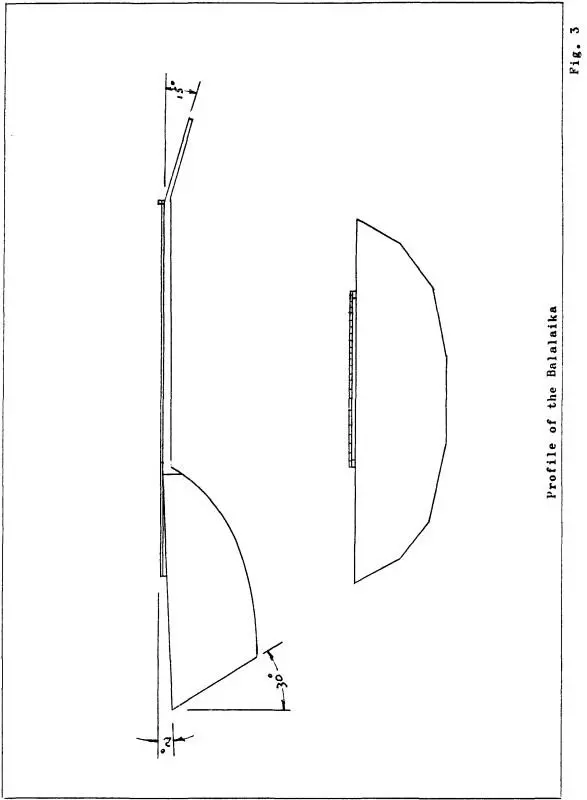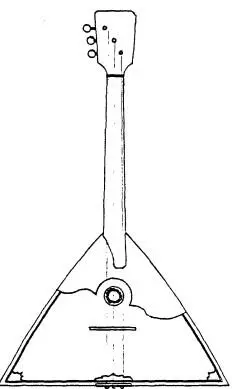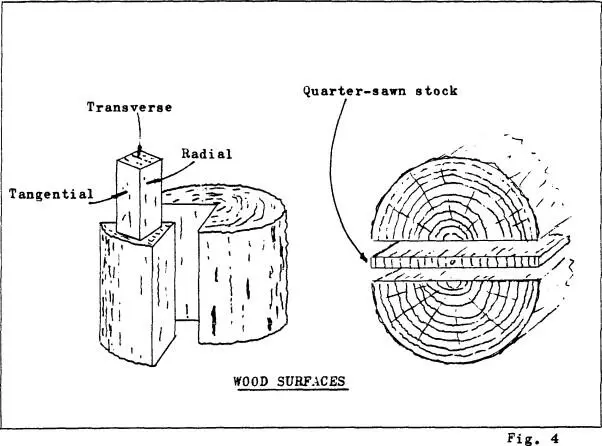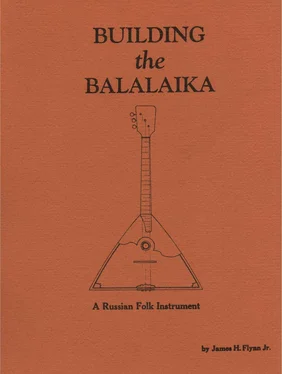James Flinn - Building the Balalaika
Здесь есть возможность читать онлайн «James Flinn - Building the Balalaika» весь текст электронной книги совершенно бесплатно (целиком полную версию без сокращений). В некоторых случаях можно слушать аудио, скачать через торрент в формате fb2 и присутствует краткое содержание. Год выпуска: 1984, ISBN: 1984, Жанр: Руководства, music, на английском языке. Описание произведения, (предисловие) а так же отзывы посетителей доступны на портале библиотеки ЛибКат.
- Название:Building the Balalaika
- Автор:
- Жанр:
- Год:1984
- ISBN:0-9613258-0-1
- Рейтинг книги:4 / 5. Голосов: 1
-
Избранное:Добавить в избранное
- Отзывы:
-
Ваша оценка:
- 80
- 1
- 2
- 3
- 4
- 5
Building the Balalaika: краткое содержание, описание и аннотация
Предлагаем к чтению аннотацию, описание, краткое содержание или предисловие (зависит от того, что написал сам автор книги «Building the Balalaika»). Если вы не нашли необходимую информацию о книге — напишите в комментариях, мы постараемся отыскать её.
Building the Balalaika — читать онлайн бесплатно полную книгу (весь текст) целиком
Ниже представлен текст книги, разбитый по страницам. Система сохранения места последней прочитанной страницы, позволяет с удобством читать онлайн бесплатно книгу «Building the Balalaika», без необходимости каждый раз заново искать на чём Вы остановились. Поставьте закладку, и сможете в любой момент перейти на страницу, на которой закончили чтение.
Интервал:
Закладка:
This publication is limited to the general construction techniques useful in building a prima balalaika. Dimensional data for the complete balalaika family are listed in Table I which can be found in the appendix. One has only to determine the size of the instrument to be constructed and then apply the same building procedures to the scaled-up model. The basic profiles of the balalaika, which are shown in Fig. 3, remain essentially the same. One exception is that the bass and contrabass instruments do not have fingerguards of the type used on the smaller instruments. This is because of the manner in which they are strummed. Some of these larger instruments have a protective piece of veneer or plastic glued on the soundboard at critical locations where the soundboard may be damaged by scratches. The two large instruments have a collapsible foot installed in a cut off portion of the left corner of the body. The foot rests on the floor thus facilitating its playing in an upright position. The dimensions shown in Table I are fairly close to average sized instruments but some minor excursions in size (up or down) can be tolerated to suit individual needs.
Because the balalaika has an official status in the Soviet Union as a "Folk Musical Instrument" builders are encouraged to faithfully follow the basic size and shape parameters. Severe ornamentation and flashy coloring is apt to produce a balalaika that looks tacky so artistically inclined luthiers should consider restricting their artistic impulses to:
a. small changes to the corner decorations and the inlay surrounding the string pegs and the lower nut;
b. tasteful changes in the decorational inlay surrounding the soundhole providing that the diameter specified is not changed;
c. minor changes in the corner cuts of the tuning head and placement of inlays in the head providing that the truncated triangular shape is maintained and that the posts of the tuning machines are in alignment with the strings as they pass over the nut;
d. layout of the veneer on the face of the transom.

Changes that affect the acoustical output of the balalaika are worthwhile from an experimenter's point of view. Examples would be in strut form and placement, bridge styles, curvature of the soundboard, etc. Such changes should be aimed at improving the resonating characteristics of the instrument, thus enhancing its volume and tone purity.

Wood
There is a piece of early .American furniture, I believe a chest of drawers made in quantity, which is certified to be an antique when the side panels are split. No split... no antique... merely a reproduction. This splitting was caused by the joinery the cabinetmaker used. Specifically, he fastened a wide, vertically grained, side panel to a horizontally grained base. In time, the side panel eventually shrank with age and dryness, however, the base did not shrink in the same direction. Consequently, the side had to give way and crack under the strain. This sort of a situation is one of the most important things to keep in mind when working with wood. Wood is always moving. It moves in a stacked pile outdoors as well as in a delicate, fully constructed, musical instrument. When we speak of moving we mean that wood is changing dimensions. In some instances the changes are large as when freshly cut lumber is drying. In other cases the changes are small as in a musical instrument made with well-seasoned wood residing in a stable environment. These dimensional changes occur because wood is "hygroscopic", that is it absorbs and releases moisture as changes in humidity and temperature occur. Therefore, it is fundamental and essential that any item fabricated from wood be made from well-seasoned stock. This means with wood which has reached its "equilibrium moisture content."
Wood exposed to an atmosphere containing moisture in the form of water vapor will come, in time, to a steady moisture-content called "equilibrium moisture content" (E.M.C.). [2] Panshin, A.J. and deZeeuw,U., Textbook of Wood Technology (McGraw-Hill New York. 1980)
Wood which has been seasoned in Santa Fe has a different EMC than that which has been cured in Washington, D. C. since these have different weather profiles.
Another way of looking at this is to consider that the EMC of wood exposed to normal conditions outdoors, but under cover, over much of the United States is about 12 to 15 percent. Under heated conditions inside buildings, the EMC will range from 8 percent to as low as 4 percent in mid-winter. For example, consider two cities with the same average temperature of 70°F but having differing relative humidity measures. The one with a 40 percent humidity would have wood with an EMC of 7,7 percent. The other city, with a high 80 percent humidity would have its wood with an EMC up to 16 percent. This is why an understanding of "wood movement" is so essential to makers of musical instruments and other fine and delicate woodworking endeavors.
Wood does not change dimensions is all directions equally. There are three dimensions, or planes, in wood and they are identified in Fig. 4. Wood shrinks very little in the transverse plane. It shrink greatest in the tangential plane and moderately in the radial plane. For example, in the tangential plane yellow birch (Betula allaghaniensis Britton) shrinks 9.5 percent in coming from the freshly-cut state to its EMC. In the radial plane it shrinks 7.3 percent. We must keep in mind that the greatest shrinkage in wood takes place in the time that it takes to reach EMC from the freshly-cut state. Some woods, even though they may have a higher shrinkage rate before hitting EMC often are very stable thereafter. The caution to be observed is that well-seasoned wood is essential to begin with; that some knowledge of its stability in its dry state be known; and, that grain orientation in placing together components of a musical instrument be carefully planned to maximize strength and stability. However, one cannot be guided solely on the dimensional stability of wood.

Other factors such as bending, machining, stiffness, hardness, color, grain patterns, etc., cannot be excluded. It seems that the more you learn about wood the more cautious you may become but eventually you must make the decision as to what kind of wood best suits some particular set of requirements. References in the attached bibliography are highly recommended for more insight into the wood behavior story.
The selection of wood for the construction of the balalaika is not too difficult. For some, it is a fairly easy matter in that personal preferences are known ahead of time...it will be rosewood from Grandmother's old piano. For others, in attempts to build the perfect instrument, it may require a great deal of time and study to search for the ideal wood which has the optimum characteristics for each part of the instrument. An example of some of the decisions to be made in the selection of the soundboard is as follows. Prime consideration is that the soundboard be resonant at the frequencies appropriate for the particular instrument. This suggests "musical" wood such as spruce or cedar. The wood must be resistant to splitting,Sitka spruce being better than western redcedar. However, the western redcedar has a more vibrant color than does the spruce. The decision to use one or the other is left to the instrument maker but also, preferably, to the player. The most important thing is that such decisions be made with full knowledge of why they were made.
Читать дальшеИнтервал:
Закладка:
Похожие книги на «Building the Balalaika»
Представляем Вашему вниманию похожие книги на «Building the Balalaika» списком для выбора. Мы отобрали схожую по названию и смыслу литературу в надежде предоставить читателям больше вариантов отыскать новые, интересные, ещё непрочитанные произведения.
Обсуждение, отзывы о книге «Building the Balalaika» и просто собственные мнения читателей. Оставьте ваши комментарии, напишите, что Вы думаете о произведении, его смысле или главных героях. Укажите что конкретно понравилось, а что нет, и почему Вы так считаете.












